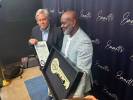Review: Las Vegas Philharmonic performance disjointed, delightful
A novel presentation of a Baroque masterpiece. A sprightly and energetic reading of a work from the ’30s not quite yet fully established as a staple of the repertoire. A masterful and graceful performance of the Third of Brahms’ four symphonies. A duet for trumpet soloists that might work better on a Pops program.
Those were the disjointed offerings during Saturday’s Philharmonic presentation.
It began with Giovanni Gabrieli’s “Canzona Septimi Toni a 2” for b rass in a successful effort to approximate the acoustics and style of early 17th century Venice.
Nearly 40 members of the Clark County School District Honor Brass Ensemble, augmented by brass players from the orchestra, entered Reynolds Hall from the rear and filled both aisles, setting the stage for the antiphonal showpiece.
Gabrieli was foremost in his time for using small ensembles placed at strategic locations to emphasize the “living stereo” effect of his performance hall; the massive and perfectly suited Cathedral of St. Mark in Venice.
The sound produced by the high school players was amazingly mature and, while Reynolds Hall’s acoustics, as good as they are, are no match for St. Mark’s, both hall and players did full justice to the brief but complex work.
Then followed “Symphony No. 3 in F major” by Johannes Brahms. This is arguably the most infrequently played and least familiar of Brahms’ four symphonies. It is highly reminiscent of Robert Schumann’s third symphony, (the “Rhenish”).
However, by the time Brahms’ work was published Schumann had been dead for nearly 25 years.
In the Brahms symphony, guest conductor Daniel Meyer earned the enthusiastic accolades he received. His approach was graceful, but never overly romantic. He showed control of the orchestra’s resources along with thorough understanding of the music’s energy and direction.
The third movement was especially poignant and its conclusion brought a hush to the audience. But not for long.
Our audience seemed compelled to interrupt the music’s flow with applause between movements, a practice that was both disrespectful to the music and often disturbing to the players.
Following intermission we heard Samuel Barber’s challenging and amusing “Overture to the School for Scandal.”
The piece was composed in 1933 while Barber was 21 and still a student at Philadelphia’s Curtis Institute. But it really isn’t an Overture to anything. Richard Brinsley Sheridan wrote his comic play “The School for Scandal” in 1777, some 156 years before Barber’s piece.
The overture follows no storyline nor was it composed for any specific production of Sheridan’s comedy. If we judge the piece on its own merits rather than attempting to tie it to a theater piece, we’ll experience sheer enjoyment — music for music’s sake.
The evening ended with a showpiece that might have fit better on a Pops program. Visiting artists Barbara Butler and Charles Geyer, trumpet virtuosos, joined the orchestra for “Carmen Fantasia,” a showpiece arrangement of familiar tunes from Bizet’s “Carmen” arranged by Donald Hunsberger, the former director of the Eastman Wind Ensemble.
The extensive piece demands endless technique and offers plenty of flash, but rarely offers the opportunity for musical artistry to show through. Of the soloists, Butler in particular showed occasional signs of struggling with notes and excessively demanding range. But it was fast, showy and designed to be a crowd-pleaser. It worked, and what are a few glitches among friends.
A delightful surprise had Butler’s father in the house celebrating a birthday in his 90s. A special arrangement of several tunes, all leading to a bit of “Happy Birthday” said, “All is forgiven; wasn’t this fun?” And it was.
REVIEW
Who: Las Vegas Philharmonic Orchestra
When: Saturday
Where: Reynolds Hall at The Smith Center for the Performing Arts
Grade: A-























